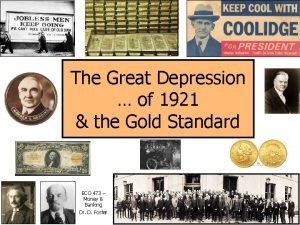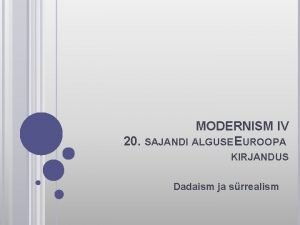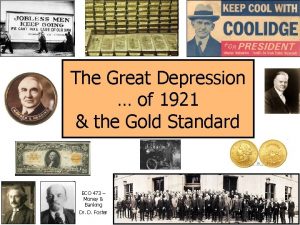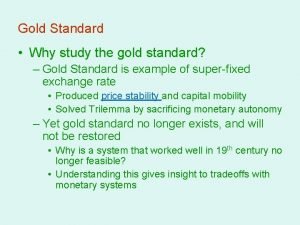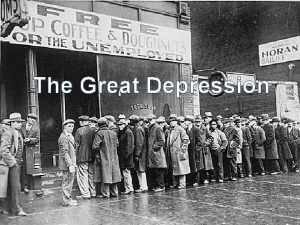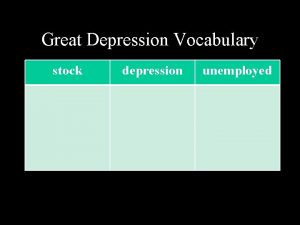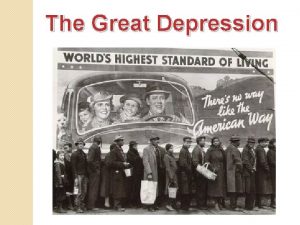The Great Depression of 1921 the Gold Standard










- Slides: 10

The Great Depression … of 1921 & the Gold Standard ECO 473 – Money & Banking Dr. D. Foster

The Great Depression of 1920 -1921 Was it necessary? • Yes – the inevitable cost of wartime inflation: Fed accommodates Treasury & buys bonds. Consumer prices: 11% in 1916 17% in 1917 18. 6% in 1918 on a pace to 14% in 1919 • Yes – the cost of transitioning back to peace: Federal budget: $2 billion in 1917 $18 billion in 1919 $5 billion in 1920 $3 billion in 1921

The Great Depression of 1920 -1921 How did it unfold? • Fed policy (individual Reserve Banks): Nov. 1919, NYF raises i (discount) to 4. 75% Jan. 1920, NYF raises i to 6% June 1920, NYF raises i to 7% May 1921, Fed banks lower i to 6. 5%, 6% • It was a depression: Real output fell an est. 9% Unemployment rose to an est. 19% Industrial production down 31% Corporate profits down 92% Prices down an est. 20%

The Great Depression of 1920 -1921 What did government do? • Presidents ignored the depression Wilson – stroke; League of Nations Harding – not the government’s place Congress spending & balanced budget Grant: “The last …” • The real recovery of 1922: Industrial production rose +26% 1921 -1922 Mfg. employment rose from 8. 2 mill. to 9 mill. 1921 -1922 Increased income, profits, confidence

How the Gold Standard works A gold standard implies that we have “fixed” exchange rates between currencies. $20. 67 = 1 oz. $50 mill. 1 oz. = £ 4. 25 $4. 86 = £ 10. 29 mill. • American firms export goods to England … tractors. Value = $50 m. • British firms export goods to U. S. … fish & chips. Value = £ 10. 29 m. • At exchange rate of $4. 86 = £ 1, the £ earned by U. S. firms will just trade for the $ earned by the British firms. • Suppose that British exports fall by 23% and that only £ 8 mill. of F&C is exported, selling for $38. 88 mill. in the U. S. .

How the Gold Standard works $20. 67 = 1 oz. $50 mill. 1 oz. = £ 4. 25 $4. 86 = £ 1 £ 8 mill. • Now, American exporters can’t exchange all of their £ 10. 29 mill. for $. • They can only exchange £ 8 mill. at the going exchange rate, receiving $38, 880, 000. But, they aren’t going to lose here… • They would cash the rest out in gold: £ 2. 29 mill. = 538, 823 oz. • They would redeem in U. S. for dollars: 538, 823 oz. = $11, 120, 000 • Total value received = $50, 000

How the Gold Standard works $20. 67 = 1 oz. $50 mill. 1 oz. = £ 4. 25 $4. 86 = £ 1 £ 8 mill. 538, 823 ounces The flow of gold from England to U. S. won’t persist over time. gold = MS = P inflation gold = MS = P deflation U. S. exports fall and British exports rise until trade flows balance.

Confounding the Gold Standard In England, the outflow of gold will lead to price deflation and probably a recession (or a depression). So, the Bank of England raises interest rates. This attracts foreign investment (capital inflows) which ends outflow of gold. In the U. S. , expanding the money supply means inflation and falling exports. The Fed can buy this gold by selling Treasury securities, so not allowing the money supply to increase. But, this will also raise U. S. interest rates which works against British policy and encourages more gold inflows!

Stress on the Gold Standard WWI - Combatant countries go off gold standard to spending. Gold rushes into the U. S. as countries buy war material. Post-WWI, gold stocks insufficient for existing price levels. Worldwide deflation (i. e. , depression) is required. The Gold Exchange Standard: U. S. & U. K. hold gold; other countries hold gold, $, £ 1929 – Great Depression begins 1933 – U. S. goes off the “pure” gold standard.

The Great Depression … of 1921 & the Gold Standard ECO 473 – Money & Banking Dr. D. Foster
